Recent Posts
Ozone Sanitation- Deodorization
3/9/2023 (Permalink)
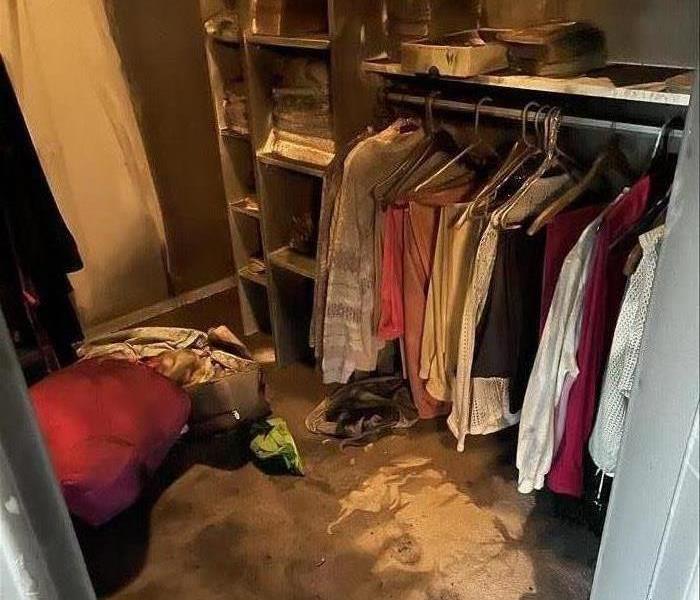 A walk-in closet with excessive smoke damage. Soft goods (clothing) were laundered and then received an ozone treatment to eliminate smoke odour.
A walk-in closet with excessive smoke damage. Soft goods (clothing) were laundered and then received an ozone treatment to eliminate smoke odour.
Odour problems from smoke? Pets? mould?
In the restoration industry we use a technique called Ozone Sanitation to remove odour.
What is Ozone??? Simply put, it is oxygen with a higher energy level, sometimes called activated oxygen. It is highly reactive blue colored gas with a distinct smell.
Ozone (O3) contains three atoms of oxygen rather than two. Ozone can oxidize all types of materials and can eliminate odours by releasing and binding the extra oxygen molecule. Over time (usually a day or so) that molecule with dissipate and go back into its original form of oxygen……removing the odour…ta da!
SERVPRO of Kelowna offers this service using trained technicians, proper equipment and following safety guidelines.
In short, we place the affected items (let’s say in this case a couch which has been in a home that was smoked in) into a vaporproof room. From there we electrically put Ozone in with a generator, using air movers to allow the ozone to disperse throughout the room.
After the couch spends a day in the ozone room and a few additional days “airing out” (letting the O3 dispel back to O2) the couch will have little to no lingering odour of smoke!!!
Ozone is EPA approved and environmentally friendly.
Flood: Can My Carpet Be Saved?
11/10/2022 (Permalink)
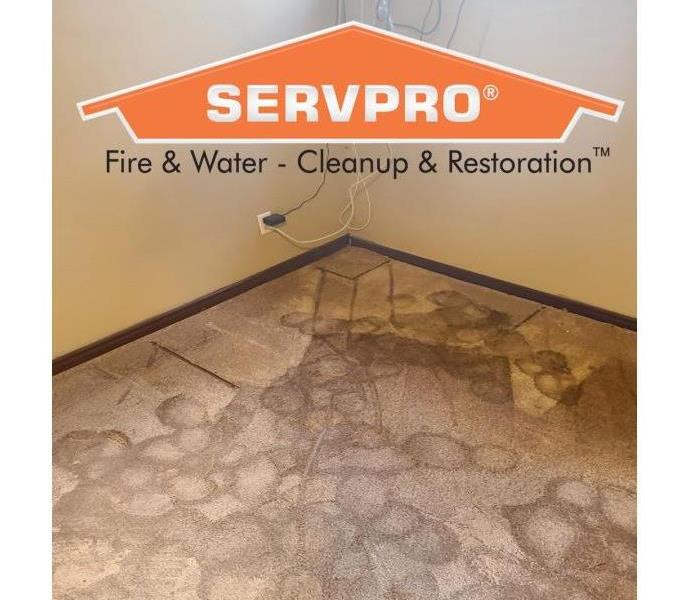 Basement flood in West Kelowna. Prior to mitigation the carpet was so saturated with water that footprints started to look like a design.
Basement flood in West Kelowna. Prior to mitigation the carpet was so saturated with water that footprints started to look like a design.
This is not a carpet design. This is a highly saturated carpet from a pipe burst in a basement wall; prior to our team extracting the water, removing the carpet pad, and placing drying equipment under & above the carpet.
During a flood in your home, many homeowners may wonder if their carpet can be saved.
The age and quality of the carpet and pad, as well as the category of water that flooded in the home is a key factor. In the restoration industry, we classify floodwater into three main categories.
Cat 1: Clean water- from a broken pipe or rainwater that has not mixed with any contaminants.
Cat 2: Greywater- is contaminated. This includes overflow from washing machines, dishwashers, toilet overflows with no solid matter, etc.
Cat 3: Blackwater- is highly contaminated. Examples include sewage, toilet backflows and weather disasters.
The water mitigation process should begin as soon as possible in any flooding event. Otherwise, the carpet can suffer permanent damage. To have a better chance of saving the carpet, contact a restoration professional immediately. We have the tools and expertise to extract, sanitize and dry the flooded carpet effectively.
In most Category 1 & 2 flooding, we can bring carpets back to life. The goal is not to replace but to restore.
A shop vacuum, towels, and home fans are no comparison for professional extraction and drying equipment. Every water damage situation is very different. Call the experts at SERVPRO. We are “Faster to Any Sized Disaster” and our goal is to have your home “Like It Never Even Happened”
Easy fan hacks to cool off!
8/17/2022 (Permalink)
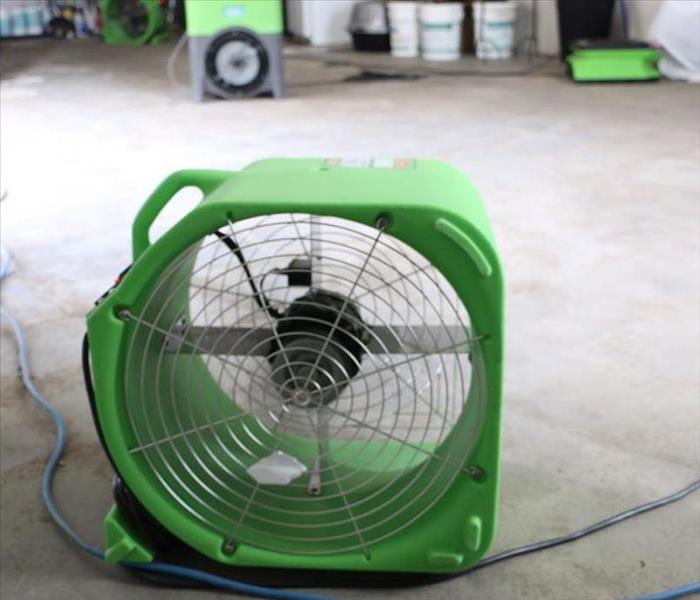 An axel fan circulating air in a garage in West Kelowna, BC.
An axel fan circulating air in a garage in West Kelowna, BC.
We are BIG fan of fans!!!
Our team uses all different types of fans daily to dry, circulate, or even scrub the air of odor/toxins.
During this heatwave fans can be a lifesaver to beat the heat.
Here are our 3 favorite “Fan Hacks” to cool down:
1. Set ceiling fans to rotate counter-clockwise. This forces the air down which provides a breeze.
2. Place a bowl of ice in front of a fan. As the ice melts the fan will blow cooler air.
3. Turn on your bathroom and kitchen fans. These exhaust fans pull hot air that rises and pushes it out of your home.
Stay hydrated and we hope you’re now a #1 fan of FANS!
Ice Dam: Signs & Prevention
2/7/2022 (Permalink)
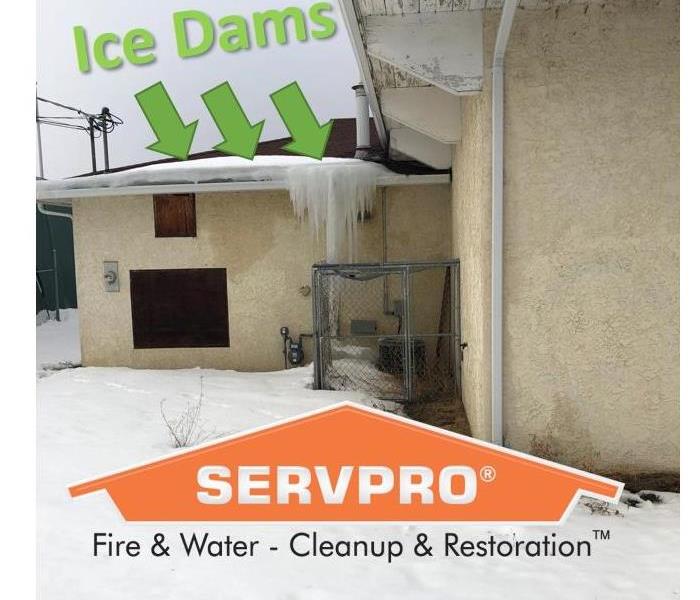 Extensive ice damming on a commercial building in West Kelowna, BC
Extensive ice damming on a commercial building in West Kelowna, BC
Those stunning icicles hanging from your roof may give your home a picturesque wintery look, but they could also be telling you that something is wrong. Icicles can be the first sign that an ice dam is present or is forming on your roof.
Ice dams prevent melting snow from escaping properly through eavestroughs and downspouts.
As standing water collects behind the ice dam, it will have nowhere to go except beneath shingles. Water underneath roof shingles may refreeze and expand as temperatures cool, which can make them break or detach. Water can then pour into your home causing water damage to drywall, framing, insulation, etc. Ice Dams can also cause extensive damage to your exterior (shingles, roof, gutters, downspouts, etc.) Not only can all these damages be costly to also poses a danger to people below.
Signs of an Ice Dam:
- Icicles on your roof
- Dark-coloured icicles
- New water-stains on your ceilings
- Different type or areas of melted snow on your roof compared to neighbors
- Dams (mounds of ice running along the edge of your roof)
Prevention:
- The best way to prevent ice damming is to properly insulate and ventilate your attic. If you are unsure if your home is adequately insulated and/or ventilated seek a professionals help to ensure the job is done right.
- Keep on top of snow removal from your roof after large snow falls. There is also chemical de-icers available in most hardware stores that can be place on your roof.
- Fall maintenance: Inspect your roof for damage, cracks, missing shingles and have any issues repaired. Clear out debris from your gutters
If you experience water damage or flooding in your home from ice damming call us today to properly access the damage and begin the restoration process.
Cleaning wildfire smoke, soot and ash from your home.
8/23/2021 (Permalink)
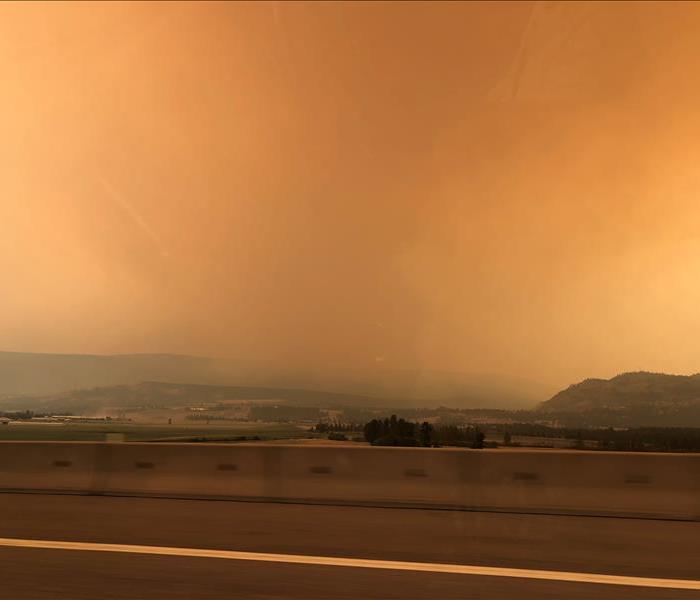 Smokey Skies over Armstrong, BC. Smoke, soot and ash have blanketed the entire BC Interior.
Smokey Skies over Armstrong, BC. Smoke, soot and ash have blanketed the entire BC Interior.
Wildfire soot and ash has blanketed our homes in the BC Interior. It collects on any and every surface, and can even enter your home when windows and doors are shut.
Before attempting to clean up ash, you need to consider your health. Ensure you wear proper personal protective equipment (PPE) to reduce inhaling ash.
Without proper protection, cleaning up ash and soot from a wildfire can be hazardous. Ash contains both large and small particles of dust, dirt, and soot. It can cause health effects when inhaled. When you’re cleaning up, ash particles can easily be swept up into the air, so we have outlined a few cleaning guidelines below:
Exterior of your home-
- Start by cleaning away ash that may cover your exterior walls or siding with a pressure washer or pressure nozzle attached to your garden hose.
- Windows and windows sills. Use a mixture of gentle dish soap (such as Dawn), and water with a microfiber towel.
- Yards; including bushes, flowers and tress should be sprayed down with clean water. DO NOT wash ash down your storm drains! (Ash is highly acidic, which can be harmful to people and the environment. Reducing the amount of ash that our local water systems need to filter is key to ensuring safe drinking water for all. TAKE CARE TO CONSERVE WATER). Instead, direct water to low traffic grassy areas. Sweep ash gently with a broom, bag and place in your trash. Using a shop vac with a HEPA filter with a disposal filter bag is also an option.
DO NOT USE LEAF BLOWERS! They will just blow the fine particles around and create more mess
Interior of your home-
- Uses a vacuum with a high-efficiency particulate air (HEPA) filter.
- Dispose of loose ash and debris in the garbage. Fabrics should be shaken out or vacuumed and washed in a washing machine.
- Furniture like couches, carpets, and curtains should be vacuumed and if needed can be sprinkled with baking soda to help deodorize the fabric.
Lastly, replace your furnace filter. You may need to do this more often than usual this summer and fall. Check your filter regularly.
Stay safe and once again THANK YOU to our amazing BC Firefighters!
Not everything can go into a microwave!
5/3/2021 (Permalink)
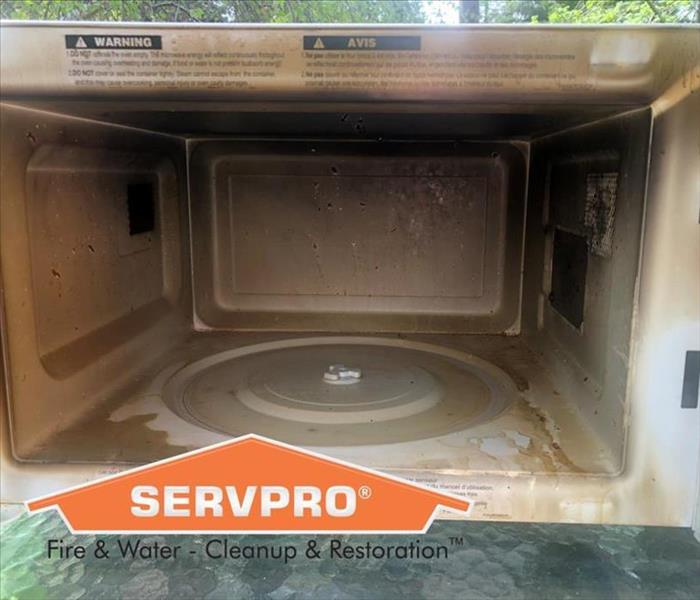 Inside of a microwave that caught on fire in a home in West Kelowna, BC. The microwave caught fire due to user heating up a take-out container.
Inside of a microwave that caught on fire in a home in West Kelowna, BC. The microwave caught fire due to user heating up a take-out container.
Microwaves are the second most common cause of residential kitchen fires! Here is a list of items that SHOULD NEVER go in a microwave:
- Paper bags
- Take-out containers
- Metal/Aluminum Foil
- Styrofoam
- Grapes (They will explode and could catch on fire)
- Cookware with metal trim
- Plastic storage containers without a “Microwave Safe” label
- Nothing (When there's nothing in the microwave to absorb the microwaves, the microwave can actually catch fire or cause damage to the microwave)
Dishwashers: Maintenance Required
2/5/2021 (Permalink)
 Drying hardwood flooring from a dishwasher leak with our SERVPRO Dri Eaz floor mat system & dehumidifier in Kelowna, BC.
Drying hardwood flooring from a dishwasher leak with our SERVPRO Dri Eaz floor mat system & dehumidifier in Kelowna, BC.
Over the year’s dishwashers have become an essential home appliance. They make our lives easier, save water, and stop us from having to wash dishes by hand.
Dishwashers are more energy-efficient and environmentally friendly than handwashing. Certified dishwasher use up to 12% less energy and 30% less water on average. Using a dishwasher can save 380 litres of water a week, when you use it every night instead of handwashing. That's over almost 19,000 litres in a year.
As much as we love our dishwashers, they can cause us some major issues if they are not regularly inspected and maintained. Did you know that 30% of water damage in residential homes are caused by appliance failure?
To avoid future water damage and/or large appliance repair bills you need to regular inspect, clean and complete maintenance on your dishwasher. Follow these simple steps to avoid possible water damage and extend the life of your appliance:
- Ensure you dishwasher is on a level surface
- Check for leaks:
- Even if there is no obvious wear or leaks, replace hoses every five years. Use a reinforced steel-braided hose, as they are less likely to fail
- Inspect & Clean spinning arms:
- Check to make sure that the arms spin correctly and clean out any debris that has accumulated inside the holes
- Clean edges, exterior & gasket:
- Edges around the door do not get washed during a regular cycle and can end up with lots of spills and pieces of food debris
- Unclog and clean the drain/filter:
- At the very bottom of your dishwasher is the drain and filter, and this area can be a common place for food debris and buildup which can eventually cause a clog. On a regular basis, you should be disassembling your drain to remove debris. Here’s how you can do this:
- Locate your owner's manual and figure out what kind of filter your dishwasher has. If it's a manual filter, you will need to take it out and wash it
- Unplug the dishwasher
- Take out the screws and remove the cover
- Clean out larger pieces by hand
- Clean out smaller deposits with a brush or cloth
- Wash filter
- Reassemble
- Run a short cycle with white vinegar or an approved dishwasher cleaning agent
If you experience a dishwasher leak, time is of the essence to reduce damage. Our team is available 24/7 for emergency services.
Welcome 2021! Home Safety Checklist
12/30/2020 (Permalink)
 Pen and paper ready to complete the 2021 Home Safety Checklist
Pen and paper ready to complete the 2021 Home Safety Checklist
2021 is only a few days away! Start the year off right.....Keep your family and possessions safe by following this home safety checklist:
- Ensure each level of your home has a working fire alarm and carbon monoxide detector
- Create a fire escape plan with your family
- Prepare a home emergency kit*Invest in a fire proof safe to keep all your irreplaceable/important documents protected*Get your vents/air ducts & dryer vent cleaned!
- Check appliances (even hair dryers and lamps) for worn or frayed cords. Damaged cords should be replaced and discarded.
- Avoid “knock-off” electrical products. (these products can easily overheat or short circuit)
- Check extension cords and wall sockets- do not overload(Don’t run cords under rugs or carpeting).
- Change your air filter and inspect your furnace
- Check your range hood and fan are fully vented and free of greasy buildup
- Check your basement for foundation cracks or damage
Lastly, create a home inventory of your belongings. Take pictures or make a video. Keep those receipts! Take pictures of receipts and file them. If you have to make a claim you will need proof of purchase!
#SERVPROKelowna #NewYears #SafetyChecklist #Restoration #BePrepared #HomeChecklist
How to Prevent Mould Growing In Your Home
11/2/2020 (Permalink)
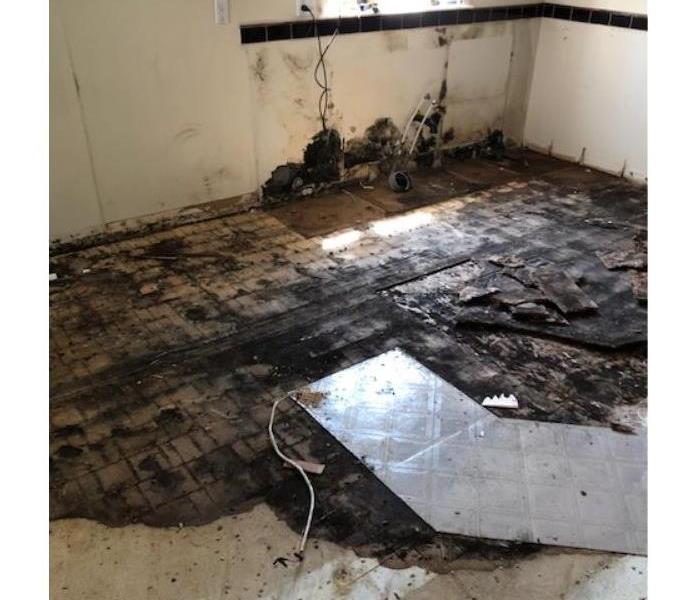 Extensive mold growth under flooring caused by a slow leak from the kitchen sink. Penticton, BC
Extensive mold growth under flooring caused by a slow leak from the kitchen sink. Penticton, BC
Mold or Mould? Canadians spell it "mould" but either way it is always finding places to grow. Large amounts of mould in your home can be problematic.....so how do you prevent mould?
Here are some great tips to reduce the chances of mold growth:
- Remove Sources of dampness
- Ensure water is directed away from the home
- Keep your home clean and dry
- Improve air flow through rooms
- Keep home below 21.7 C and between 30-50% humidity
Thanksgiving Dinner Fire Safety
10/8/2020 (Permalink)
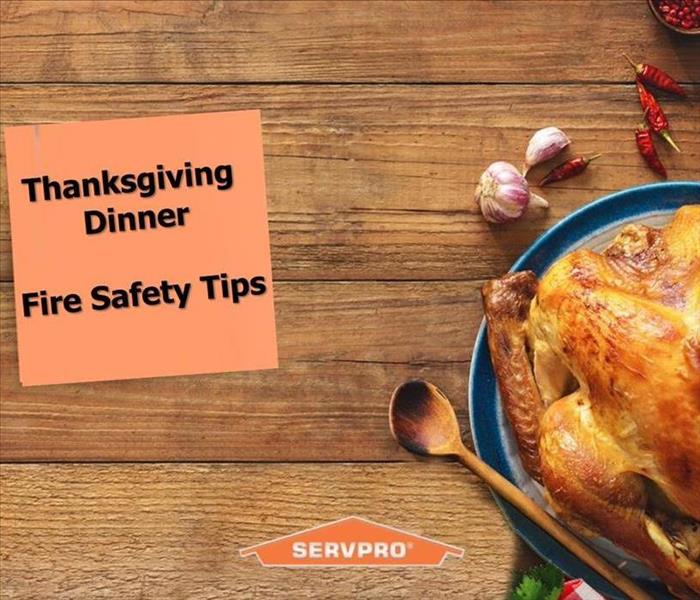 Happy Thanksgiving from the SERVPRO of Kelowna Team
Happy Thanksgiving from the SERVPRO of Kelowna Team
Oct 4 to 10th is “Fire Safety” week. As many of us will be gathering to enjoy a yummy Thanksgiving feast this weekend, we wanted to provide some reminders and tips for your Thanksgiving dinner:
- Ensure your smoke alarms are connected and working
- Never leave your food unattended. Use a timer and routinely check you’re cooking
- If frying or deep-frying, keep the fryer outside, away from walls and moisture
- Ensure pot holders and food wrappers are always at a safe distance from the stove
- Avoid wearing dangling accessories or loose clothes while cooking
- Never douse a grease fire with water!! Turn off the burner, smother the flames, or douse with baking soda……or use a fire extinguisher
- Keep a fire extinguisher handy in the kitchen, and know how to use it
 A walk-in closet with excessive smoke damage. Soft goods (clothing) were laundered and then received an ozone treatment to eliminate smoke odour.
A walk-in closet with excessive smoke damage. Soft goods (clothing) were laundered and then received an ozone treatment to eliminate smoke odour.

 24/7 Emergency Service
24/7 Emergency Service








